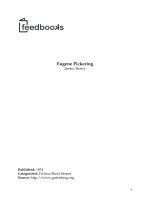Carbohydrates - By Henry Wormser - PhD Professor Of Medicinal Chemistry
Bạn đang xem bản rút gọn của tài liệu. Xem và tải ngay bản đầy đủ của tài liệu tại đây (5.66 MB, 160 trang )
Carbohydrates
By
Henry Wormser, Ph.D.
Professor of Medicinal Chemistry
PSC 3110 Fall 2010
Reading in Garrett & Grisham
textbook
Chapter 7 pages 205- 240 – (quite complete discourse
on carbohydrate structure and function with some
emphasis on cell surfaces)
several figures presented in these notes are taken from
The G & G chapter
In Lehninger’s book read chapter 7
Web videos URLs
/>Presented by Eric Allain – Assistant professor at Alalachian university
/> />Presented by Prof. S. Dasgupta, Dept of Chemistry, IIT Kharagpur
Institute of Technology at Kharagpur, India
Carbohydrates
General characteristics
•
the term carbohydrate is derived from the
french: hydrate de carbone
•
compounds composed of C, H, and O
•
(CH
2
O)
n
when n = 5 then C
5
H
10
O
5
•
not all carbohydrates have this empirical
formula: deoxysugars, aminosugars
•
carbohydrates are the most abundant
compounds found in nature (cellulose: 100
billion tons annually)
General characteristics
•
Most carbohydrates are found naturally in
bound form rather than as simple sugars
•
Polysaccharides (starch, cellulose, inulin, gums)
•
Glycoproteins and proteoglycans (hormones, blood group
substances, antibodies)
•
Glycolipids (cerebrosides, gangliosides)
•
Glycosides
•
Mucopolysaccharides (hyaluronic acid)
•
Nucleic acids
Functions
•
sources of energy
•
intermediates in the biosynthesis of other basic
biochemical entities (fats and proteins)
•
associated with other entities such as glycosides,
vitamins and antibiotics)
•
form structural tissues in plants and in
microorganisms (cellulose, lignin, murein)
•
participate in biological transport, cell-cell
recognition, activation of growth factors,
modulation of the immune system
Classification of carbohydrates
•
Monosaccharides (monoses or glycoses)
•
Trioses, tetroses, pentoses, hexoses
•
Oligosaccharides
•
Di, tri, tetra, penta, up to 9 or 10
•
Most important are the disaccharides
•
Polysaccharides or glycans
•
Homopolysaccharides
•
Heteropolysaccharides
•
Complex carbohydrates
Monosaccharides
•
also known as simple sugars
•
classified by 1. the number of carbons and 2.
whether aldoses or ketoses
•
most (99%) are straight chain compounds
•
D-glyceraldehyde is the simplest of the aldoses
(aldotriose)
•
all other sugars have the ending ose (glucose,
galactose, ribose, lactose, etc…)
C
C
CH
2
OH
OH)n(H
O
H
Aldose
C
C
CH
2
OH
OHH
O
H
Aldotriose
n = 1
C
CH
2
OH
OHH
C O
H
C OHH
Aldotetrose
n = 2
C
CH
2
OH
OHH
C O
H
C OHH
C OHH
Aldopentose
n = 3
C O
H
C OHH
C OHH
CH OH
C
CH
2
OH
OHH
Aldohexose
n = 4
Aldose sugars
C
C
CH
2
OH
OH)n(H
O
CH
2
OH
Ketose
CH
2
OH
C O
CH
2
OH
Ketotriose
n = 0
CH
2
OH
C O
C OHH
CH
2
OH
Ketotetrose
n = 1
C OHH
CH
2
OH
CH
2
OH
C O
C OHH
Ketopentose
n = 2
C OHH
CH
2
OH
CH
2
OH
C O
C OHH
OHH
Ketohexose
n = 3
Ketose sugars
Structure of a simple aldose and a simple ketose
C
CH
2
OH
OHH
C O
H
C OHH
C
CH
2
OH
HOH
C O
H
C HOH
these two aldotetroses are enantiomers.
They are stereoisomers that are mirror
images of each other
C O
H
C HHO
C HHO
CH OH
C
CH
2
OH
OHH
C O
H
C HHO
C HHO
CHO H
C
CH
2
OH
OHH
these two aldohexoses are C-4 epimers.
they differ only in the position of the
hydroxyl group on one asymmetric carbon
(carbon 4)
Enantiomers and epimers
•
Differences in structures of sugars are
Differences in structures of sugars are
responsible for variations in properties
responsible for variations in properties
•
Physical
•
Crystalline form; solubility; rotatory power
•
Chemical
•
Reactions (oxidations, reductions, condensations)
•
Physiological
•
Nutritive value (human, bacterial); sweetness;
absorption
sugars
•
Fisher projection: straight chain
representation
•
Haworth projection: simple ring in
perspective
•
Conformational representation: chair
and boat configurations
Rules for drawing Haworth
projections
•
draw either a six or 5-membered ring
including oxygen as one atom
•
most aldohexoses are six-membered
•
aldotetroses, aldopentoses, ketohexoses
are 5-membered
O
O
Rules for drawing Haworth
projections
•
next number the ring clockwise starting next to
the oxygen
•
if the substituent is to the right in the Fisher
projection, it will be drawn down in the
Haworth projection (Down-Right Rule)
O
O
1
2
3
4
5
1
2
3
4
Rules for drawing Haworth
projections
•
for D-sugars the highest numbered
carbon (furthest from the carbonyl) is
drawn up. For L-sugars, it is drawn
down
•
for D-sugars, the OH group at the
anomeric position is drawn down for
α and up for β. For L-sugars α is up and
β is down
Optical isomerism
•
A property exhibited by any compound
whose mirror images are non-
superimposable
•
Asymmetric compounds rotate plane
polarized light
POLARIMETRY
Measurement of optical activity in chiral or
asymmetric molecules using plane polarized light
Molecules may be chiral because of certain atoms or
because of chiral axes or chiral planes
Measurement uses an instrument called a
polarimeter (Lippich type)
Rotation is either (+) dextrorotatory or (-)
levorotatory









